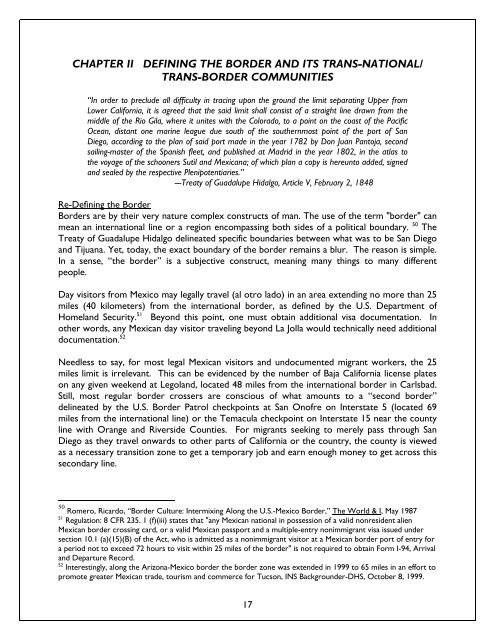Blurred Borders - International Community Foundation
Blurred Borders - International Community Foundation
Blurred Borders - International Community Foundation
You also want an ePaper? Increase the reach of your titles
YUMPU automatically turns print PDFs into web optimized ePapers that Google loves.
CHAPTER II DEFINING THE BORDER AND ITS TRANS-NATIONAL/<br />
TRANS-BORDER COMMUNITIES<br />
“In order to preclude all difficulty in tracing upon the ground the limit separating Upper from<br />
Lower California, it is agreed that the said limit shall consist of a straight line drawn from the<br />
middle of the Rio Gila, where it unites with the Colorado, to a point on the coast of the Pacific<br />
Ocean, distant one marine league due south of the southernmost point of the port of San<br />
Diego, according to the plan of said port made in the year 1782 by Don Juan Pantoja, second<br />
sailing-master of the Spanish fleet, and published at Madrid in the year 1802, in the atlas to<br />
the voyage of the schooners Sutil and Mexicana; of which plan a copy is hereunto added, signed<br />
and sealed by the respective Plenipotentiaries.”<br />
---Treaty of Guadalupe Hidalgo, Article V, February 2, 1848<br />
Re-Defining the Border<br />
<strong>Borders</strong> are by their very nature complex constructs of man. The use of the term "border" can<br />
mean an international line or a region encompassing both sides of a political boundary. 50 The<br />
Treaty of Guadalupe Hidalgo delineated specific boundaries between what was to be San Diego<br />
and Tijuana. Yet, today, the exact boundary of the border remains a blur. The reason is simple.<br />
In a sense, “the border” is a subjective construct, meaning many things to many different<br />
people.<br />
Day visitors from Mexico may legally travel (al otro lado) in an area extending no more than 25<br />
miles (40 kilometers) from the international border, as defined by the U.S. Department of<br />
Homeland Security. 51 Beyond this point, one must obtain additional visa documentation. In<br />
other words, any Mexican day visitor traveling beyond La Jolla would technically need additional<br />
documentation. 52<br />
Needless to say, for most legal Mexican visitors and undocumented migrant workers, the 25<br />
miles limit is irrelevant. This can be evidenced by the number of Baja California license plates<br />
on any given weekend at Legoland, located 48 miles from the international border in Carlsbad.<br />
Still, most regular border crossers are conscious of what amounts to a “second border”<br />
delineated by the U.S. Border Patrol checkpoints at San Onofre on Interstate 5 (located 69<br />
miles from the international line) or the Temacula checkpoint on Interstate 15 near the county<br />
line with Orange and Riverside Counties. For migrants seeking to merely pass through San<br />
Diego as they travel onwards to other parts of California or the country, the county is viewed<br />
as a necessary transition zone to get a temporary job and earn enough money to get across this<br />
secondary line.<br />
50 Romero, Ricardo, “Border Culture: Intermixing Along the U.S.-Mexico Border,” The World & I, May 1987<br />
51 Regulation: 8 CFR 235. 1 (f)(iii) states that "any Mexican national in possession of a valid nonresident alien<br />
Mexican border crossing card, or a valid Mexican passport and a multiple-entry nonimmigrant visa issued under<br />
section 10.1 (a)(15)(B) of the Act, who is admitted as a nonimmigrant visitor at a Mexican border port of entry for<br />
a period not to exceed 72 hours to visit within 25 miles of the border" is not required to obtain Form I-94, Arrival<br />
and Departure Record.<br />
52 Interestingly, along the Arizona-Mexico border the border zone was extended in 1999 to 65 miles in an effort to<br />
promote greater Mexican trade, tourism and commerce for Tucson, INS Backgrounder-DHS, October 8, 1999.<br />
17















